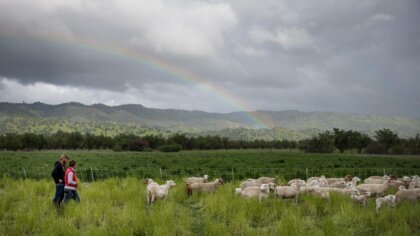
What Sonoma County can do about the climate crisis

By Jerry Bernhaut —
The international summit on climate change in Egypt this past November, COP27, resulted in an agreement among the developed countries primarily responsible for the climate crisis to create a fund to support the developing countries coping with the impacts of climate disasters. The wider agreement – the “Sharm el-Sheikh Implementation Plan” – excluded any mention of phasing out the use of fossil fuels. This is likely the result of the reported presence of 600 fossil-fuel lobbyists. It then devolves to individual high emitting countries, states and local jurisdictions to voluntarily take the necessary action to avoid the worst effects of the climate crisis becoming irreversible.
The near-term timeline for averting irreversible catastrophic planetary warming calls for a 45% reduction in carbon emissions by 2030, according to the Intergovernmental Panel on Climate Change (IPCC). All governments calculate reduction in their carbon dioxide (CO2) emissions as a combination of reducing emissions generated by human activity and alleged levels of carbon emissions stored (sequestered) after they are generated, so they do not persist in the atmosphere to contribute to global warming.
Sequestration can be by natural means, such as tree planting and soil management which removes carbon from the atmosphere, and by technical measures to capture and store CO2 at the point of discharge from fossil-fuel burning power stations and industrial operations before the CO2 emissions enter the atmosphere.
According to advocates of electrification like physicist Saul Griffith, author of Electrify, and Mark Jacobson, professor of civil and environmental engineering at Stanford University, electrifying our fossil fuel economy would result in a significant overall reduction in energy demand, with estimates varying from 42 to 50 percent, because electric power is more energy efficient than combustion of fossil fuels. If the electricity is generated by non-fossil fuel energy sources such as wind and solar power, hydro, the geothermal power plant operating at The Geysers in Sonoma County, then the reduction in energy demand by electrification would result in a comparable reduction in carbon emissions.
In theory this is a feasible path to resolving the climate crisis. In practice, as Richard Heinberg of the Post Carbon Institute has said, full transition to electrification powered by non-fossil fuel, renewable energy sources will require the replacement of an extraordinary amount of infrastructure in our food system, manufacturing, building heating and cooling, transportation, the construction industry and on and on. The only realistic way to make the transition at sufficient scale in industrial countries like the U.S., in time to avoid irreversible warming, is to begin reducing overall energy usage substantially as we transition to electrification from renewables.
Heinberg is regarded as one of the world’s foremost advocates for a shift away from our current reliance on fossil fuels. Bill McKibbin, founder of 350.org, acknowledged “Post Carbon Institute is doing the most important work imaginable, and doing it well.”

Natural sequestration is highly effective and one essential part of the solution. We must preserve existing forests, plant more trees wherever we can and adopt policies that leverage state and privately owned natural and working lands to their fullest carbon removing potential. This includes the benefits of reducing or eliminating nitrous oxide emissions from synthetic fertilizers when farmers and ranchers use healthy soils practices or transition to organic agriculture. These solutions are also significantly less expensive than the technological solutions.
Current prevailing industrial logging and agricultural practices do not support natural carbon removal and sequestration. Transitioning to policies more protective of existing forests and supportive of regenerative land management at a significant scale will take time. It is part of the solution but does not eliminate the need to reduce overall energy demand.
The effectiveness of technical sequestration, known as carbon capture and sequestration (CCS), is doubtful. I found a consensus among credible sources that CCS is an unproven technology that has failed to produce promised results.
From the Center for International Environmental Law (CIEL): “At best, CCS prevents some CO2 generated by the combustion of carbon-based fuels from reaching the atmosphere—provided that the captured CO2 is not later released. In practice, however, the few CCS projects implemented to date have repeatedly failed to achieve promised capture rates. No amount of investment in CCS can accelerate the needed transition to a fossil-free future. CCS locks in place the underlying polluting source, extending its operation while creating additional risks, impacts, and costs associated with the CCS infrastructure itself. CCS is neither necessary to avoiding catastrophic levels of warming nor feasible at scale, and poses significant risks to communities and the climate.”
From the Climate Center, here in Sonoma County, commenting on the Cal. Air Resource Board Updated Scoping Plan: “CARB Must Not Rely on Failed or Unproven Carbon Removal Technologies that Lock in Climate Pollution and Exacerbate Environmental Injustice in order to achieve carbon neutrality by 2035. As a baseline, CARB must ensure that the Scoping Plan does not rely on carbon capture and storage (CCS) – which operates at the smokestack and does not remove past emissions from the atmosphere – to achieve its goals. None of the existing CCS projects attached to fossil fuel extraction operations have captured the amount of carbon they claimed they would, despite the fact that the technology has existed for decades and should therefore be much more mature. Indeed, the most widely cited “successful” project in Saskatchewan only captures 44% of its carbon dioxide emissions, not the promised 90%. Even if they are successful, the main result is the perpetuation of fossil fuel burning. To add to this, CCS is expensive, with captured carbon costing as much as $140/ton for power generation. CCS\has been shown to fail 80% of the time in the U.S.”
If Heinberg is correct, which I think he clearly is, we must reduce overall energy demand by continuing to improve the efficiency of appliances, machinery and vehicles through electrification and by scaling back economic activity, as we transition to a non-fossil fuel economy. This is the only realistic hope of averting irreversible catastrophic global warming. Techno-optimists like Griffith and Jacobson present a broad theoretical framework where they claim this transition via electrification, to a non-fossil fuel economy, is feasible in an economy based on perpetual growth. They do not factor in the real-life countervailing forces including the enormous infrastructure expense and the deep-pocketed vested interests in current practices and potentially stranded assets, which resulted in the failure of COP 27, the compromised Inflation Reduction Act (IRA) and CARB Scoping Plan.
The denial of the need to scale down our material economies to a level consistent with the planet’s finite resources and carrying capacity is pervasive at every level of government and internationally, as the failure of COP 27 demonstrated.
At the national level for the U.S.A, the recently passed Inflation Reduction Act (IRA) has been promoted as “the most aggressive action ever, ever, ever to confront the climate crisis and increase our energy security — ever in the whole world” by President Biden. He praised the IRA as demonstrating that we can solve the climate crisis and maintain economic growth. He clearly saw that as politically necessary.
The IRA provides substantial tax credits for wind, solar and battery technologies. However, it also reinstates an 80-million-acre Gulf of Mexico oil and gas lease sale previously overturned by a federal judge because the Department of Interior failed to address the climate impacts from developing the leases. The bill would also require the Interior Department to offer at least 2 million acres of public lands and 60 million acres of offshore waters for oil and gas leasing each year for a decade as a prerequisite to installing any new wind or solar energy facilities on public lands. If the Department failed to offer this required acreage for oil and gas leases, no right of ways could be granted for any utility-scale renewable energy projects on public lands or waters. This political compromise was called a “climate suicide pact” by the Center for Biodiversity, one of the most respected environmental groups.
The official prediction that the IRA will reduce U.S. carbon emissions by roughly 40 percent by 2030, despite the increased fossil fuel production, is based on estimates of transition to non -fossil fuel energy resulting from the incentives of the tax credits. Energy Innovation Policy & Technology LLC, an energy and climate policy think tank which provides customized research and policy analysis to decision-makers, modeled the IRA’s impact on emissions. The modeling Report included the caveat that the model assumes that necessary transmission will be built, interconnection delays are addressed, and supply chains provide the necessary materials. (The vast infrastructure replacement Heinberg spoke of) The Report then cited federal and state policy proceedings and legislation which “could” address these concerns. The question remains whether these practical challenges are likely to be met at the necessary scale in the required timeline. This technical analysis does not consider the inevitable resistance of vested interests in stranded fossil-fuel assets.
At the California State level, the recent CARB Scoping Plan update, the Plan for achieving the State’s carbon reduction goals, does not clearly identify which policies will be used to reduce emissions in order to meet the 2030 targets. CARB assumes that mechanical carbon capture and storage, CCS, will be installed on 70 percent of refineries by 2030. CARB is relying on the unproven assumptions about the effectiveness of carbon capture and a flawed cap-and-trade program to offset carbon emissions while declining to adopt clear policies to reduce carbon emissions at their source.
At the County level, Sonoma County continues to pursue policies based on a flawed Climate Action Plan (CAP) which was invalidated by court order in 2017 as violating the California Environmental Quality Act (CEQA) . The County’s wine and tourist industry generates GHG emissions from millions of vehicle miles traveled (VMT) by air and sea from global tourist air travel and wine export by air and sea. The CAP excluded all GHG emissions from VMT beyond County borders and nearby Bay Area destinations in its calculation of the County’s contribution to global emissions.
The court ruled that the CAP’s Inventory of County GHG emissions was based on insufficient information. The County’s decisions to issue permits for vineyard and winery development, tourist venues, resulted in significant GHG emissions the County was required by CEQA to account for. Despite the CAP being declared legally invalid, the County continued to rely on it as an “advisory document” to make false claims as a leader in climate policy.

The County has implemented some good emissions reduction policies through Sonoma Clean Power (visit its Advanced Energy Center on 4th Street in Santa Rosa, above, to learn how to electrify your home) and the adoption of building energy codes requiring new commercial structures to include solar panels and energy storage, and requiring new dwellings to have all-electric appliances, with the exception of cooktops. However, when it comes to the dominant business model of tourism and wine production for global export, our cities and the County promote international tourism and large-scale growth. There are plans for significant long-term expansion of capacity at the County airport. This business as usual approach is clearly counter to any County claims of climate leadership.
At every level of government there is adoption of technology for GHG reduction, some effective like building electrification, some doubtful at best, like carbon capture. At the same time there is continued growth in high GHG emission industries, including gas and oil production, air travel and over consumption.
It is increasingly clear that reducing overall energy demand is essential to avoid reaching the tipping point beyond which catastrophic planetary warming is irreversible. This means there is no sustainable path for avoiding catastrophic global warming that includes continued economic growth. We must reduce global economic activity, measured by gross domestic product as we transition to renewable non-fossil fuel energy sources. Our economies must become more localized, less dependent on global supply chains. We should eat locally grown food as much as possible, buy locally produced goods, and generally consume less. This is in direct opposition to dominant corporate practices of globalization, outsourcing to exploit low wage labor, planned obsolescence in high-tech industries and our general consumer driven economy stimulated by relentless advertising.
There is clear consensus that our current extreme weather is the result of global warming. Some level of long term environmental harm is already irreversible, but I believe we can still make a significant difference. We can avoid the worst effects, leave a habitable planet for future generations, if we have the ability to make fundamental systemic changes.
.Jerry Bernhaut, a resident of the Sonoma Valley for 45 years, is an attorney for California River Watch. He is a member of the Sierra Club State Committee on Climate and Energy, and has served as a member of the Citizens’ Advisory Committee to the Sonoma County Transportation Authority and as a member of the Sonoma Valley Citizens’ Advisory Committee. He lives in Oakmont.
.
2 thoughts on “What Sonoma County can do about the climate crisis”
Comments are closed.







Yup, smaller, adaptive reuse development at SDC. Yup, no more giant luxury resort hotels. Too bad our BOS, does not understand what is in this piece.
What’s left unsaid here is who is paying for the SDC lawsuit and the extreme high likelihood that those monies come from investments based on “growth.” And, that the SDC-Glen Ellen- Sonoma Mtn. area is one of luxury material lifestyle and very high wealth that was gained through investments in “growth.” Whose interests are being protected here? To put 350+ out of 700 or 1000 homes at SDC that will house the people who serve the wealthy-invest-in- growth folks is somehow out of “scale?” What’s missing from Jerry’s stop-growth sustainability equation here is full cost accounting, the triple bottom line, and social equity. Sustainability is not all climate and environment, an economy and society that can also endure at scale and not throw the poor under the bus is also part of the deal. If the bottom 20% of people are not lifted up to a minimum level of secure, economic well-being, it won’t matter how many wildlife corridors or home gardens you have, the whole human house of cards is coming down bc of failure to share the goods and to share the space. What I see with this suit and at SDC is like the science fiction movies where the wealthy sequester themselves away and leave the hoi polloi to suffer and die on the margins, unfortunate collateral damage of “over population.” Tough luck if you haven’t already invested in growth. Sonoma won’t save SDC either bc scale and density are resisted here by pockets of wealthy growth investors who are against growth as well.